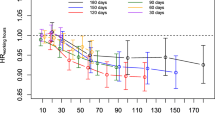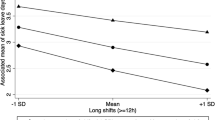Abstract
Purpose
To test the association between night work and work ability, and verify whether the type of contractual employment has any influence over this association.
Methods
Permanent workers (N = 642) and workers with precarious jobs (temporary contract or outsourced; N = 552) were interviewed and filled out questionnaires concerning work hours and work ability index. They were classified into: never worked at night, ex-night workers, currently working up to five nights, and currently working at least six nights/2-week span.
Results
After adjusting for socio-demography and work variables, current night work was significantly associated with inadequate WAI (vs. day work with no experience in night work) only for precarious workers (OR 2.00, CI 1.01–3.95 and OR 1.85, CI 1.09–3.13 for those working up to five nights and those working at least six nights in 2 weeks, respectively).
Conclusions
Unequal opportunities at work and little experience in night work among precarious workers may explain their higher susceptibility to night work.
Similar content being viewed by others
References
Axelsson J, Akerstedt T, Kecklund G, Lowden A (2004) Tolerance to shift work—how does it relate to sleep and wakefulness? Int Arch Occup Environ Health 77:121–129. doi:10.1007/s00420-003-0482-1
Bartley M (2005) Job insecurity and its effect on health. J Epidemiol Community Health 59:718–719. doi:10.1136/jech.2004.032235
Benach J, Muntaner C (2007) Precarious employment and health: developing a research agenda. J Epidemiol Community Health 61:276–277. doi:10.1136/jech.2005.045237
Benach J, Amable M, Muntaner C, Benavides FG (2002) The consequences of flexible work for health: are we looking at the right place? J Epidemiol Community Health 56:405–406. doi:10.1136/jech.56.6.405
Benavides FG, Benach J, Diez-Roux AV, Roman (2000) How do types of employment relate to health indicators? Findings from the second European survey on working conditions. J Epidemiol Community Health 54:494–501. doi:10.1136/jech.54.7.494
Bernhard-Oettel C, Sverke M, De Witte H (2005) Comparing three alternative types of employment with permanent full-time work: how do employment contract and perceived job conditions relate to health complaints? Work Stress 19:301–318. doi:10.1080/02678370500408723
Bohle P, Quinlan M, Kennedy D, Williamson A (2004) Working hours, work-life conflict and health in precarious and permanent employment. Rev Saude Publica 38(Suppl):19–25
Camerino D, Conway PM, Sartori S, Campanini P, Estryn-Béhar M, van der Heijden BI, Costa G (2008) Factors affecting work ability in day and shift-working nurses. Chronobiol Int 25:425–442. doi:10.1080/07420520802118236
Chan CCA, McBey K, Basset M, O’Donnell M, Winter R (2004) Nursing crisis: retention strategies for hospital administrators. Res Pract Hum Resour Manage 12:31–56
Costa G, Sartori S (2007) Ageing, working hours and work ability. Ergonomics 50:1914–1930. doi:10.1080/00140130701676054
Costa G (2003) Factors influencing health of workers and tolerance to shift work. Theor Issues Ergon Sci 4:263–288. doi:10.1080/14639220210158880
D’Souza RM, Strazdins L, Lim LL, Broom DH, Rodgers B (2003) Work and health in a contemporary society: demands, control, and insecurity. J Epidemiol Community Health 57:849–854. doi:10.1136/jech.57.11.849
Ferrie JE (2001) Is job insecurity harm to health? J R Soc Med 94:71–76
Ferrie JE, Shipley MJ, Stansfeld SA, Ferrie Marmot MG (2002) Effects of chronic job insecurity and change in job security on self reported health, minor psychiatric morbidity, physiological measures, and health related behaviours in British civil servants: the Whitehall II study. J Epidemiol Community Health 56:450–454. doi:10.1136/jech.56.6.450
Frese M, Okonek K (1984) Reasons to leave shiftwork and psychological and psychosomatic complaints of former shiftworkers. J Appl Psychol 69:509–514. doi:10.1037/0021-9010.69.3.509
Goudswaard A, Nanteuil M (2000) Flexibility and working conditions: a qualitative and comparative study in seven EU Member States. Office for Official Publications of the European Communities, Luxembourg
Ilmarinen J (2007) The work ability index (WAI). Occup Med 57:160. doi:10.1093/occmed/kqm008
Office International Labour (2002) Framework guidelines for addressing workplace violence in the health sector. ILO, International Council of Nurses, World Health Organization and Public Services International, Geneve
Kivimäki M, Vahtera J, Virtanen M, Elovainio M, Pentti J, Ferrie JE (2003) Temporary employment and risk of overall and cause-specific mortality. Am J Epidemiol 158:663–668. doi:10.1093/aje/kwg185
Knutsson A (2003) Health disorders of shift workers. Occup Med 53:103–108. doi:10.1093/occmed/kqg048
Kujala V, Remes J, Ek E, Tammelin T, Laitinen J (2005) Classification of work ability index among young employees. Occup Med 55:399–401. doi:10.1093/occmed/kqi075
Kundi M, Koller M, Cervinka R, Haider M (1986) Health and psychosocial aspects of shiftwork results of a 5-year follow-up study. In: Nachreiner F (ed) Studies in industrial and organizational psychology, vol 3. Verlag Peter Lang, Frankfurt
Letourneux V (1998) Precarious employment and working conditions in Europe. Office for Official Publications of the European Communities, Luxembourg
Loudon RJ, Bohle PL (1997) Work/non-work conflict and health in shiftwork: relationships with family status and social support. Int J Occup Environ Health 3(Suppl 2):S71–S77
Marquié JC, Foret J (1999) Sleep, age, and shiftwork experience. J Sleep Res 8:297–304. doi:10.1046/j.1365-2869.1999.00170.x
Menendez M, Benach J, Muntaner C, Amable M, O’Campo P (2007) Is precarious employment more damaging to women’s health than men’s? Soc Sci Med 64:776–781. doi:10.1016/j.socscimed.2006.10.035
Meyers LS, Gamst G, Guarino AJ (2005) Applied multivariate research—design and interpretation. Sage Inc, Thousand Oaks
Pohjonen T (2001) Perceived work ability of home care workers in relation to individual and work-related factors in different age groups. Occup Med (Lond) 51:209–217. doi:10.1093/occmed/51.3.209
Portela LF, Rotenberg L, Waissmann W (2004) Self-reported health and sleep complaints among nursing personnel working under 12 h night and day shifts. Chronobiol Int 21:859–870. doi:10.1081/CBI-200038513
Quinlan M, Mayhew C, Bohle P (2001) The global expansion of precarious employment, work disorganization, and consequences for occupational health: a review of recent research. Int J Health Serv 31:335–414. doi:10.2190/607H-TTV0-QCN6-YLT4
Ribeiro-Silva F, Rotenberg L, Soares RE, Pessanha J, Ferreira FL, Oliveira P, Silva-Costa A, Benedito-Silva AA (2006) Sleep on the job partially compensates for sleep loss in night-shift nurses. Chronobiol Int 23:1389–1399. doi:10.1080/07420520601091931
Rutenfranz J, Haider M, Koller M (1985) Occupational health measures for night workers and shiftworkers. In: Folkard S, Monk T (eds) Hours of work: temporal factors in work scheduling. Wiley, New York
Ruyter A (2004) Casual work in nursing and other clinical professions: evidence from Australia. J Nurs Manag 12:62–68
Sverke M, Hellgren J, Näswall K (2002) No security: a meta-analysis and review of job insecurity and its consequences. J Occup Health Psychol 7:242–264. doi:10.1037/1076-8998.7.3.242
Trinkoff A, Geiger-Brown J, Brady B, Lipscomb J, Muntaner C (2006) How long and how much are nurses now working? Am J Nurs 106:60–71
Tuomi K, Huuhtanen P, Nykyri E, Ilmarinen J (2001) Promotion of work ability, the quality of work and retirement. Occup Med 51:318–324. doi:10.1093/occmed/51.5.318
Tuomi K, Ilmarinen J, Hakola A, Katajarinne L, Tulkki A (1998) Work ability index. Finish Institute of Ocuupational Health, Helsinky
Tuomi K, Ilmarinen J, Hakola A, Katajarinne L, Tulkki A (2005) Work ability index. Adaptation to Portuguese by Fischer, FM EDUFSCAR, São Carlos
Virtanen M, Kivimäki M, Elovainio M, Vahtera J, Cooper CL (2001) Contingent employment, health and sickness absence. Scand J Work Environ Health 27:365–372
Virtanen M, Kivimaki M, Joensuu M, Virtanen P, Elovainio M, Vahtera J (2003) Temporary employment and health: a review. Int J Epidemiol 34:610–622. doi:10.1093/ije/dyi024
Wedderburn A (2000) Shiftwork and health. Foundation for the Improvement of Working and Living Conditions, Dublin
Aknowledgments
We are grateful to the Workers’ Health Commission from the studied hospitals for the support. Financial support: CNPq, FAPERJ, Mount Sinai School of Medicine. LR and FMF are Irving Selikoff International Fellows of the Mount Sinai School of Medicine ITREOH Program. Their work was supported in part by grant 1 D43 TW00640 from the Fogarty International Center of the National Institutes of Health.
Author information
Authors and Affiliations
Corresponding author
Rights and permissions
About this article
Cite this article
Rotenberg, L., Griep, R.H., Fischer, F.M. et al. Working at night and work ability among nursing personnel: when precarious employment makes the difference. Int Arch Occup Environ Health 82, 877–885 (2009). https://doi.org/10.1007/s00420-008-0383-4
Received:
Accepted:
Published:
Issue Date:
DOI: https://doi.org/10.1007/s00420-008-0383-4




